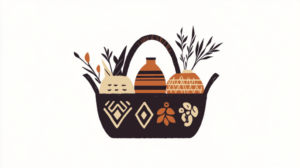
An Overview of Mindanao’s Local Products
A Guide for Visitors and Residents
Mindanao is a land rich in culture, tradition, and natural resources, all of which are reflected in its diverse array of local products. From unique crafts and antiques to fresh produce and delectable cuisine, the island offers a wide range of items that are not only perfect souvenirs but also provide insight into the region’s rich heritage. Here’s a detailed look at what Mindanao has to offer.
Mindanao’s local products offer a fascinating glimpse into the island’s rich cultural tapestry. Whether you’re interested in sampling unique flavors, purchasing one-of-a-kind crafts, or learning about traditional skills, Mindanao has something to offer every visitor. Embracing these local products not only enhances your experience of the island but also supports the communities that keep these traditions alive.

Local Produce
Fruits and Vegetables
- Durian: Often called the “King of Fruits,” durian is perhaps the most famous product of Mindanao, particularly in Davao. Known for its strong aroma and creamy texture, it’s a must-try for adventurous eaters.
- Mangosteen: This “Queen of Fruits” is another staple in Davao, known for its sweet and tangy flavor. It’s also believed to have numerous health benefits.
- Pomelo: A large citrus fruit similar to grapefruit, pomelo from Mindanao is prized for its sweet and slightly tart flavor. It’s often enjoyed fresh or used in salads and desserts.
- Cacao: Mindanao is a leading producer of cacao, the raw ingredient for chocolate. The island’s cacao is used in both local and international chocolate products, with Davao being particularly known for its artisanal chocolates.

Seafood and Meat
- Tuna: General Santos City is dubbed the “Tuna Capital of the Philippines,” and for good reason. The city’s tuna, particularly yellowfin, is exported globally and is a favorite among locals and visitors alike.
- Lechon: This roasted pig is a staple at Filipino celebrations, and Mindanao’s version is particularly crispy and flavorful. Lechon from the regions of Davao and Cagayan de Oro is especially renowned.

Handicrafts and Artisanal Products
Woven Products
- T’nalak: A traditional cloth woven by the T’boli people of South Cotabato, T’nalak is made from abaca fibers and features intricate patterns that are said to be inspired by dreams. The cloth is highly prized and used in various products, from clothing to home decor.
- Yakan Weaving: The Yakan people of Basilan are known for their vibrant, geometric weaves. Their fabrics are used in clothing, bags, and accessories, and each design often has symbolic meanings related to their culture.

Woodcrafts and Furniture
- Maranao Woodcrafts: The Maranao people from Lanao del Sur are famous for their okir designs, which are intricate carvings that adorn various wooden items like furniture, musical instruments, and home decor. These designs often feature traditional motifs like the sarimanok (a legendary bird) and naga (a serpent-like creature).
- Antiques and Souvenirs: Mindanao is a great place to find unique antiques and collectible items, such as old brass gongs, tribal jewelry, and carved wooden chests. These items often reflect the island’s rich history and cultural diversity.

Metalwork and Jewelry
- Brassware from Cotabato: The towns of Cotabato are known for their brass items, including trays, vases, and gongs. These items are often intricately designed and make for unique souvenirs or home decor.
- Silver and Gold Jewelry: Mindanao, particularly the provinces of Surigao, has a long history of gold mining. Local artisans create beautiful pieces of jewelry, often incorporating traditional designs.

Cuisine and Delicacies
Local Dishes
- Sinigang na Hipon: A sour shrimp soup that is a staple in many Mindanao households. It’s made with tamarind, tomatoes, and various vegetables, offering a flavorful and comforting dish.
- Kinilaw: Often compared to ceviche, kinilaw is a dish made from raw fish marinated in vinegar, calamansi (local lime), and spices. It’s a popular appetizer or main dish in coastal areas.
- Satti: A dish popular in Zamboanga, satti consists of skewered meats (similar to satay) served with a spicy, rich sauce and rice cooked in coconut leaves. It’s a favorite street food that offers a taste of the region’s culinary diversity.

Snacks and Pastries
- Pastel: A sweet, soft bun filled with yema (custard) or other fillings like ube (purple yam) and cheese. Originally from Camiguin, pastel has become a popular snack across Mindanao.
- Durian Candy: For those who might find the raw fruit too overwhelming, durian candy offers a sweeter, more approachable way to enjoy this famous fruit. These candies are often found in souvenir shops.

Beverages
- Sikwate: A traditional hot chocolate made from tablea (pure cacao tablets). Sikwate is often enjoyed during breakfast or merienda (afternoon snack), paired with local delicacies like suman (sticky rice).
- Tuba: A traditional fermented drink made from coconut sap, tuba is enjoyed across the island. It’s similar to palm wine and can be found in local markets and bars.

Skills and Services
Traditional Healing Practices
- Hilot: An ancient Filipino art of healing, hilot is a massage technique that’s believed to align the body’s energies and relieve various ailments. Many rural areas in Mindanao still practice hilot, and some wellness centers offer this traditional service.
- Herbal Medicine: Many Mindanaoans still rely on herbal medicine, using plants and herbs to treat common ailments. Some areas even have herbalists who are well-versed in these traditional remedies.

Local Crafts and Workshops
- Basket Weaving: Various indigenous groups in Mindanao, such as the Manobo and Higaonon, are known for their basket-weaving skills. These baskets are often used for practical purposes but are also sold as decorative items.
- Pottery: Traditional pottery is still practiced in certain areas, with some communities offering workshops for visitors interested in learning the craft.

Fun Facts and Cultural Insights
- Superstitions: Many Mindanaoans still hold on to superstitions, such as not cutting your nails at night or not sweeping the floor after sundown, as these are believed to bring bad luck.
- Skin Color Hang-ups: Like in many parts of the Philippines, lighter skin is often idealized, and many Filipinos use whitening products. However, there’s also a growing movement embracing moreno (brown) skin, celebrating the natural beauty of the Filipino complexion.
- Cultural Beliefs: The people of Mindanao are deeply connected to their cultural heritage, with many communities still practicing rituals and traditions that have been passed down for generations. For example, the T’boli people have a practice called “dreamweaving,” where their weavers create intricate patterns inspired by their dreams.

Where to Find and Buy Local Products
Markets and Souvenir Shops
- Aldevinco Shopping Center in Davao City: Known for its wide array of souvenirs, including traditional textiles, jewelry, and crafts. It’s a one-stop shop for anyone looking to take a piece of Mindanao home with them.
- Cultural Villages: Many regions have cultural villages or centers where you can purchase authentic local products directly from the artisans. These places also often offer demonstrations and workshops.

Specialty Stores and Online Shops
- Davao’s Cacao City: A specialty store in Davao City dedicated to promoting locally produced chocolates and cacao products. It’s a must-visit for chocolate lovers.
- Online Platforms: Many local artisans and producers are now selling their goods online, making it easier for visitors and residents to purchase unique Mindanao products from the comfort of their homes.
The standard voltage in Mindanao is 220V, and the frequency is 60Hz, with power outlets typically accepting Type A, B, and C plugs. Most urban areas have reliable electricity, but in some rural or remote areas, power outages can occur. It’s a good idea to have a portable charger or power bank for your devices, especially if you plan to travel outside the cities.



